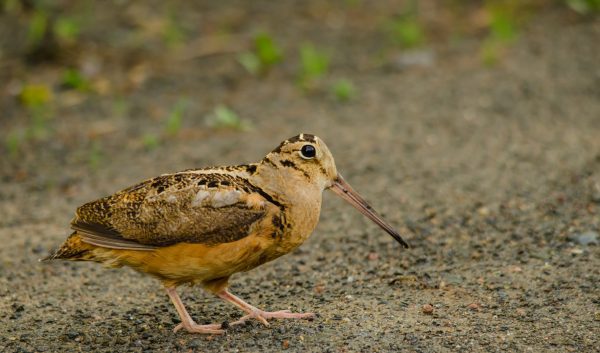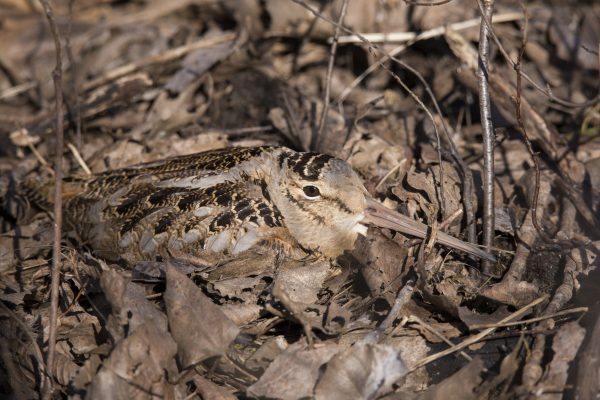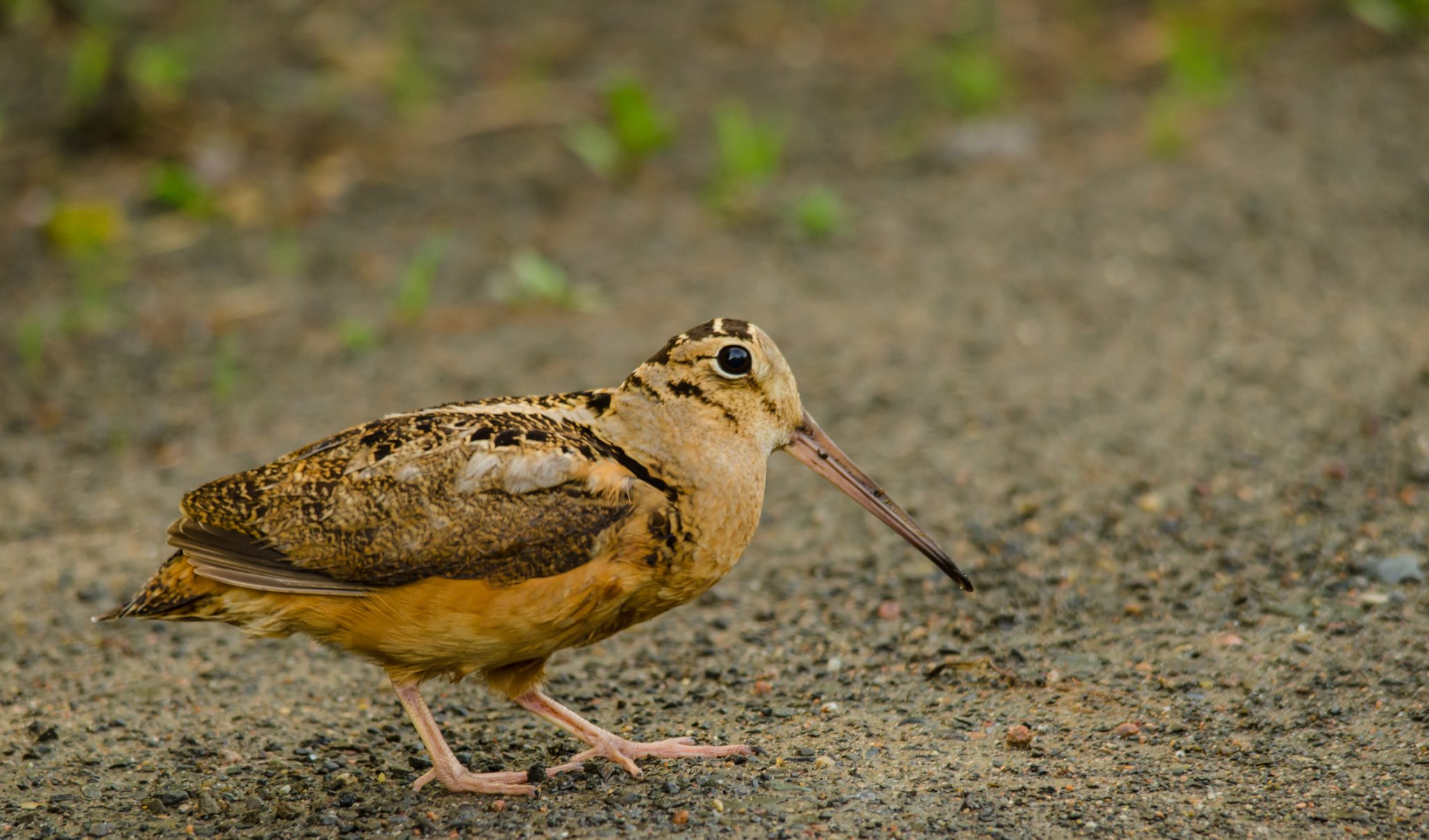Forestry & Wildlife

The American woodcock is a migratory game bird valued by nature lovers and hunters alike. Conservation of the species relies on land management that supports their habitat needs.

Figure 1. American woodcock (Scolopax minor). Note the long beak.
The American woodcock (Scolopax minor) is a quail- sized bird known by many names. Among these are timberdoodle, wood snipe, bog sucker, and night partridge (figure 1).
Because woodcocks are not waterfowl, no state or federal duck stamp is required for hunting. Hunters must participate, however, in the Migratory Bird Harvest Information Program (HIP). American woodcock season in Alabama runs from mid-December through the end of January. On average, 300 Alabama hunters take part in woodcock season, harvesting 2,000 birds annually.
As with many migratory bird species, American woodcock numbers are in decline. With proper habitat management strategies and adherence to harvest regulations, this trend can be reversed.
Biology
The woodcock is found throughout eastern North America. Although some woodcocks will spend the entire year in the state, most will be around only during the winter. As springtime approaches, many will migrate north. With Alabama’s geographic location along the center of the Gulf Coast, birds may migrate to either the Northeast or Midwest United States, with some traveling as far as the Canadian province of Manitoba.

Figure 2. American woodcocks are well-camouflaged against leaf litter, as shown by this female woodcock on a nest.
The woodcock is perhaps best known for its distinctive mating display in spring and summer. It consists of a series of “peent” calls followed by a “sky dance,” during which the male performs a spiraling flight from hundreds of feet in the air. Visit The Cornell Lab All About Birds website to hear American woodcock calls and sounds. Both males and females have similar plumage that is mottled brown and black; this provides camouflage against leaf litter (figure 2).
Sometimes confused with the snipe due to their similarity of appearance, American woodcocks are a different species. Both snipe and woodcock belong to the family Scolopacidae, collectively known as sandpipers. Whereas the snipe is associated with wetlands, the American woodcock is considered an upland bird. Both are commonly classified as game species in many states. American woodcocks rely on a diversity of habitats. Because they depend on worms as a food source, woodcocks prefer moist bottomland thickets and proximity to seepage where worms are most abundant. These earthworm specialists use their long, flexible beaks to probe soft soils for their preferred food, which can make up 90 percent of their diet.
Singing grounds, where the courtship display occurs, are typically in forest clearings, fields, orchards, or other open areas. Nesting cover is in early successional, open, second-growth stands close to singing grounds. When a woodcock has finished foraging for a day, it typically seeks an open field in which to roost for the night.
Conservation
Unlike many other bird species, woodcocks are difficult to detect using standardized surveys like the North American Breeding Bird Survey or Christmas Bird Count. This difficulty necessitates further studies to determine population trends.
Leading causes of species decline include habitat loss and alteration. Urbanization, particularly in the mid-Atlantic, has removed suitable habitat for the species, while forest maturation, monocultural pine plantations, and fire suppression have degraded habitat in the South. The decline of early successional forests has been met with notable decreases in singing populations of woodcocks, along with many other migratory bird species. States such as Florida have lost millions of acres of feeding and roosting habitat to succession. The fragmentation of privately owned forestland, along with rapid urbanization, has transformed millions more. As a result, singing male woodcock populations have declined 35 to 75 percent from the 1970s to the present day.
Declines have been drastic enough that the American woodcock is now listed as a “species of greatest conservation need” in Virginia, North Carolina, South Carolina, Alabama, Mississippi, and Louisiana. As such, they require the most attention in a state’s wildlife action plan. The pressures on the species are representative of a multitude of conservation and restoration challenges throughout the eastern half of the United States.
Ongoing research by the Alabama Department of Conservation and Natural Resources in collaboration with the Eastern Woodcock Migration Research Cooperative seeks to better understand where woodcocks migrate during the warmer months. This is accomplished by capturing birds in winter and attaching satellite transmitters that transmit location data during and after migration. The goal is to better understand important migration stopover locations and how migration destinations change due to habitat loss.
Although the U.S. Fish and Wildlife Service does not conduct the American Woodcock Singing-ground Survey in Alabama, hunters can help inform management decisions by accurately reporting their woodcock harvests through HIP.
Habitat Management
Because the American woodcock is a migratory species, effective population and habitat management needs to be implemented across its range to reverse the observed population declines. By focusing on habitat management and adhering to harvest regulations, Alabamians can do their part to positively affect management outcomes.
Following are habitat management measures that can benefit American woodcock populations. Bear in mind that these management activities are specific to the needs of the American woodcock. Before implementing any of them, verify that they will not negatively affect other management goals for the property.
Daytime cover. Woodcocks require the right combination of moisture, soil, and cover during the day to forage and hide. Identifying these areas is important for keeping woodcocks around. If poorly drained soil is present, encourage growth of the understory and shrub cover. If historic ditches or drainage tiles exist in these areas, consider modifying or removing them to retain more soil moisture in the surrounding area.
Fields. Mow fields in the fall at the end of the growing season. Mowing in patches during this time may help create winter foraging areas. Ensure that this mowing regimen does not negatively impact other wildlife management goals on the property. Additional ways to create a patchwork of cover and open space are discing, herbicide application, prescribed fire, and encouraging native shrub and tree growth across the open parts of the property. The ultimate goal is to create and maintain early successional habitat in these areas.
Forests. Although mature pine monocultures make poor woodcock habitat, thinning and clear-cutting patches can create suitable habitat. After a clear-cut, woodcocks may utilize that area for several years. Try to avoid planting and cutting wetter sites, which are naturally better for hardwoods, as they provide the ideal daytime cover for woodcock foraging. Consider leaving behind some slash, which will further contribute to the patchiness that woodcocks prefer. Finally, prescribed fire can be used to thin out dense understories.
Longleaf pine forests tend to be better woodcock habitat than pine monocultures. These forests, which once covered a vast area of the South, have been reduced to a fraction of their former size through a long history of land use changes, development, and fire suppression. Restoration and management of longleaf habitat require an optimal burn interval of 1 to 4 years.
The reintroduction of fire in the longleaf region has benefits beyond increasing habitat foraging quality for woodcocks. Studies have shown that woodcocks are more likely to roost in burned fields within the region, demonstrating the usefulness of fire in maintaining a diversity of early successional habitats within the wider longleaf mosaic. Woodcocks also prefer to establish nests in more open, lower-density portions of forest, with correlations to lower basal areas and relatively lower levels of woody stems. The classic longleaf forest structure would meet these habitat preferences.
Regardless of forest type, consider employing even- aged stand management, particularly in upland habitats adjacent to wetter areas with short rotations. If possible, emphasize shade-intolerant hardwoods. Before harvest, delay, limit, or exclude site preparation and herbicides, which decrease habitat suitability. The minimum harvest size should be at least five acres. Finally, at the time of harvest, make log landings as large as possible to improve roosting field habitat postharvest.
Conclusion
The American woodcock is a species that has historically delighted bird watchers and hunters alike. Its unique appearance combined with its interesting behaviors makes the woodcock part of our natural heritage that we should work to conserve.
Managing land for woodcocks results in more than just helping the species in Alabama. People in the Northeast and Midwest may benefit, as well, as they get to enjoy some of these same birds during the warmer months. Many of the habitat management strategies and restoration activities that benefit woodcock also benefit other plant and animal species.
Further Reading
- Kelley, J. R., S. Williamson, and T. R. Cooper. 2008. American Woodcock Conservation Plan: A Summary of and Recommendations for Woodcock Conservation. U.S. Fish and Wildlife Publications, 430.
- Krementz, D. G., and J. J. Jackson. 2009. Woodcock in the Southeast: Natural History and Management for Landowners.
- Leopold, A., and C. W. Schwartz. 1949. A Sand County Almanac, and Sketches Here and There. Oxford University Press.
- Rainer, D. 2021. “Woodcock Monitoring Program Tracks Migration Routes.” Alabama Department of Conservation and Natural Resources. www. outdooralabama.com/articles/woodcock-monitoring- program-tracks-migration-routes.
- Straw, J. A., Jr., D. G. Krementz, M. W. Olinde, and G. F. Sepik. 1994. “American Woodcock.” In Migratory Shore and Upland Game Bird Management in North America, edited by T. C. Tacha and E. E. Braun, 97–116. International Association of Fish and Wildlife Agencies. Lawrence, KS: Allen Press.
 Daniel Danza, Graduate Certificate Student, Wesley Anderson, Extension Specialist, Assistant Professor, Adam Maggard, Extension Specialist, Assistant Professor, and John Kush, Retired Research Fellow, all in Forestry, Wildlife, and Natural Resources, Auburn University
Daniel Danza, Graduate Certificate Student, Wesley Anderson, Extension Specialist, Assistant Professor, Adam Maggard, Extension Specialist, Assistant Professor, and John Kush, Retired Research Fellow, all in Forestry, Wildlife, and Natural Resources, Auburn University
New August 2021, Game Management: The American Woodcock, FOR-2107

